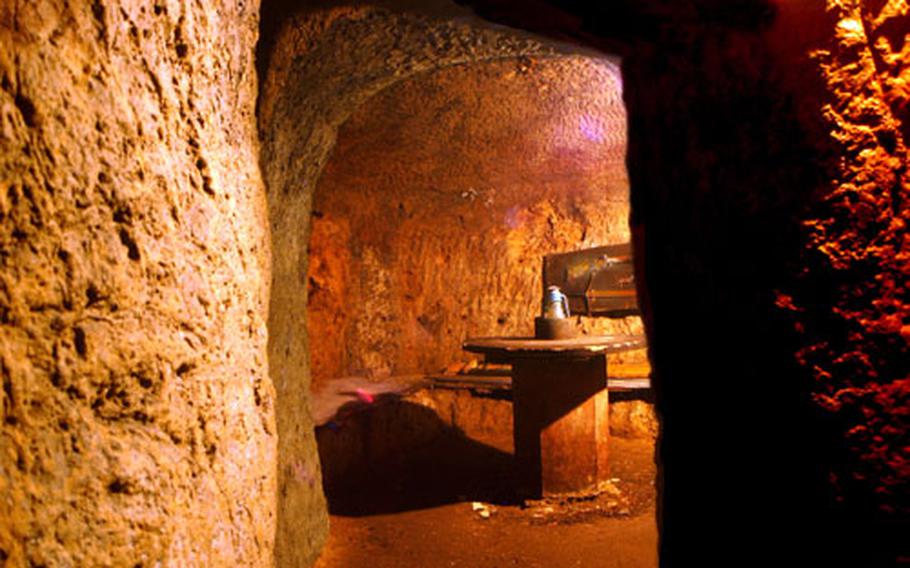
The original entrance to the cave where Heinrich Anton Leichtweiss hid out was behind the sign, just a small hole. The cave was created naturally. Called the Leichtweisshöhle, it is about two miles outside the Wiesbaden city limits. (Peter Jaeger / S&S)
In 1880, W.A. Roeder published the German novel “Heinrich Anton Leichtweiss, the daring robber and poacher, or 13 years of love and faith inside the rock grave.” While the story was an exaggeration typical of 19th-century tales of knights, robbers and their romantic affairs, it did have some truth.
Three items in the book’s title are facts: Heinrich Anton Leichtweiss was a historical figure; he was a poacher; and he hid for 18 months in a cave in the wild woods outside of Wiesbaden.
The cave — called Leichtweisshöhle, or Leichtweiss’ cave — today is a favorite destination for families and school classes. It is a simple place, with the walk to the cave as interesting as the final destination.
What makes the cave noteworthy is the story behind it, the story of Leichtweiss, even without the sensational enhancements.
Walter Czysz, a Wiesbaden historian, studied Leichtweiss’ life by using documents he discovered at the Hessian archive in Wiesbaden.
Here are some of his findings:
Between 1757 and 1788, Leichtweiss lived in the small village of Dotzheim, outside Wiesbaden. He was an educated and respected member of the community, who could read and write. He was married, had seven children and owned the tavern Zum Goldenen Engel. He also worked as a tax collector.
The year 1788 turned his respectable life around. He was accused of breaking into the cellar of a neighbor and rumors of poaching in the forests of Count Karl Wilhelm of Nassau- Usingen led to his arrest.
The legal documents are vague and controversial. Leichtweiss claimed his break-in was revenge for a fight with neighbors, and that he never was a poacher. He may have been the victim of a smear campaign and jealousies in a small community. Nevertheless, he was sentenced to six months in prison. Karl Wilhelm increased the penalty to one year in prison and one day in the pillory at the marketplace of Wiesbaden.
When Leichtweiss left prison in October 1789, he was a broken man. He never returned to his family and disappeared in the deep forests surrounding Wiesbaden, living the life of a poacher.
Forest workers discovered his hideout when they spotted smoke from a cave fire in 1791, but he escaped. Six months later he was caught in the Hessian town of Bergen and brought back to Wiesbaden. Even though his new poaching crimes were done outside Nassau-Usingen, he was sentenced without a trial to life in prison in Wiesbaden. Wilhelm’s personal interest in the sentence was again evident.
Leichtweiss died in prison in 1793 at age 69.
The Leichtweisshöhle is a monument to Leichtweiss and the legend around him — a victim of feudal authority and hardship.
The original entrance to the cave is quite small, but the interior was enlarged by forest workers. They created a small room, with a table, chair and stone bed where Leichtweiss is supposed to have stayed.
A second, larger entrance was cut into the cave after Roeder’s book was published, and the cave became a popular place to visit. That entrance is used today.
For a small donation, visitors can listen to a German-speaking guide tell Leicht- weiss’ story and illuminate the area where he hid.
It doesn’t take long to see the cave, but the pleasant walk and a chance to hear the story make it worthwhile.
Know and go ...DIRECTIONS: The Leichtweisshöhle is about two miles outside the Wiesbaden city limits at the Nerotal. Drive up Wilhelmstrasse, turn left at the end onto Taunusstrasse, which leads into Nerotal, a park. Stay on the road at the right until you see the viaduct of the Nerobergbahn, the mountain railway leading to the top of the hill, and park underneath. Or use bus No. 1, direction Nerotal, from the main train station to final stop. From there, a sign points to the Leichtweisshöhle. A paved curved road leads through the forest to the cave, a pleasant 25-minute hike or short bike ride.
TIMES: The cave is open to the public April to October: 10 a.m. to 2 p.m. on Wednesdays, 2-6 p.m. on Fridays. 2-6 p.m. on Sundays.
COSTS: There is no admission, donations are accepted by a friendly guard, Rudolf Driess, who works on a volunteer basis.
FOOD: There is none at the cave, but there is a picnic area and an operating well behind the cave. Driess sells bottled water and fruit juice. An excellent restaurant is located opposite the cable car. The Beau Site is open daily, noon to 2:30 p.m. and 6 p.m. until midnight.
INFORMATION: Driess, who does not speak English, opens the cave for groups on demand; call him at 0611-54539. To learn more about Leichtweiss see www.leichtweiss.de.
— Peter Jaeger